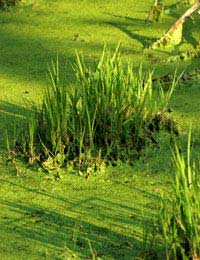
Pond algae are a natural occurrence, which occurs in any pond as free-floating matter if left untreated after a period of time. It manifests itself as a collection of tiny slimy plants such as plankton and string algae and this can ruin the appearance of a pond which can, if left untreated, take on a thick, green pea-soup appearance which is not only unappealing to the eye but which can also be damaging to fish and other aquatic wildlife which may be living in and around the pond.
Causes Of Pond Algae
There can be several reasons why your pond is filled with algae. These can include:
- Hot and humid weather and exposure to too much direct sunlight
- Stagnant water with no pond filters
- Rotting leaves and other debris contained in the pond
- Excessive levels of phosphate and nitrate in the pond and a higher pH level in the pond due to the use of marble, limestone or concrete
- Insufficient healthy aquatic plants which can absorb nutrients from the pond
How To Control Pond Algae
There are many different methods you can adopt to restrict the formation of pond algae growth and here are some suggestions.
Pond Construction
It all begins with how you construct your pond in the first place. Debris such as rotting leaves will tend to settle near the bottom of a pond. Therefore, by designing a slope at the deepest point of the pond, any debris will slide down into that which makes it far easier to gather up and remove all from the same area later.
It’s also a good idea to build something like a pond wall to prevent run-off rainwater from getting into the pond as this would naturally increase its pH level. Having different depths within the pond is useful too as the deepest areas will help the growth of aquatic plants which will absorb a lot of the nutrients from the water for their own growth which restricts the amounts of nutrients left over to feed algae and so prevents its formation.
Plants which grow on the surface such as water lilies and lettuce should also be encouraged as by settling on top of the pond’s surface, this helps to restrict the amount of sunlight from penetrating the pond which in turn starves the algae which thrives on sunlight.
Debris, particularly decaying leaves should be cleared regularly which you can do manually or via proper skimmers in pond filters and when constructing a pond, try not to situate it directly underneath the branches of a deciduous tree which is always going to shed its leaves directly into the pond at the end of each summer.
Other Solutions
Ultraviolet sterilisers work by damaging the DNA of the algae in a perfectly safe way and they are also effective in getting rid of other micro-organisms and pond bacteria resulting in a crystal-clear pond. Approved algaecides are a chemical solution to the problem of algae. However, they can also harm aquatic plants and wildlife so it is not the best solution if you’re a keen wildlife gardener looking to attract wildlife to your pond.
Barley straw and barley straw extract are also effective in keeping the water clear and your pond odour-free. As for fish that you might keep in your pond, you can introduce fish which thrive on algae as part of their diet and, given that many brands of fish feed contain nitrates and phosphates which algae also thrives on, one of the methods you should adopt in feeding fish is to give them a little less of the fish feed itself and let them supplement their diet by feeding on algae.
There are numerous other techniques you can adopt in an effort to keep your pond algae free such as pond dyes, magnetic systems, ozone and chlorine treatments to name but a few but before going out and ordering any specific product, you should seek expert advice first.




do you know what a clouds are in the water they are white
I have thousands of minute “leaves” floating on the surface. I have two small and quite deep ponds, one over the other. The top pond has an overflow to the lower, which contains the pump. There is little weed at all in the upper pond. What is the weed and how can I treat it please?
Have a pond approx 1000L capacity. It is used to supply an aquaponics grow bed. I would like to remove the algae from the pond through a physical filter however it seems the ‘pea soup’ algae is too small to be captured by any fabric I have attempted to use. I do not want to use a dye, uv filter or algaside as there are fish and plants for consumption involved. Is there a filter available that is able to trap such small single celled organisms? The only method I can think of at the moment is to place some timber lengths over the pond and then restrict the light with a cover. Any advice would be appreciated. Regards, Andrew
In full sun 16ft x8ft x3ft6ins at its deepest3 yrs old. the wildlife pond has developed on the surface 2 to 3 ins of thick jelly which crusts over in strong sunshine. lots of the tadpoles died this nyear please help.what is it?